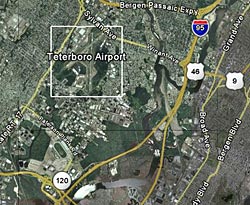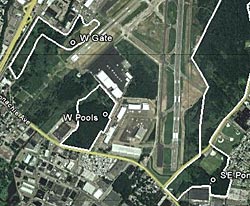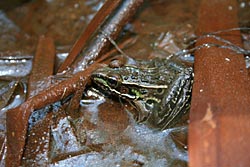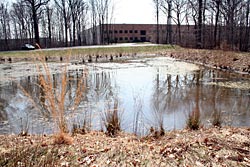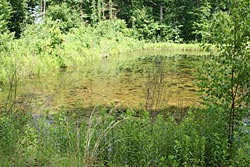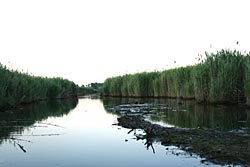Frog Call Surveys in an Urban Wetland Complex, the Hackensack Meadowlands, New Jersey, in 2006
by Erik Kiviat
Hudsonia Ltd., P.O. Box 5000 / 30 Campus Rd., Annandale, New York 12504
Abstract
In many areas of the world, frogs are affected by multiple environmental stresses. Therefore, the presence or absence of frogs may serve as an indicator of the quality of urban environments. On three occasions in spring 2006, I surveyed calling frogs for three-hour periods at each of two sites in the Hackensack Meadowlands just outside New York City in northeastern New Jersey, USA. I detected small choruses of a single species, southern leopard frog (Lithobates sphenocephalus utricularius [Rana sphenocephala utricularia]), at multiple wetland and pond locations within each site. The occurrence of populations of this species in the Meadowlands is noteworthy because it is rare or disappearing in nearby regions. The tolerance of the southern leopard frog for slightly brackish water and its need for only small areas of adjoining upland habitat may enable it to survive in a coastal urban environment. The absence or scarcity of other frog species may be a result of unsuitability of the habitat, or fragmentation may prevent them from recolonizing following extirpation due to historic land use and hydrological alteration in the Meadowlands.
Keywords: Amphibia, monitoring, southern leopard frog (Lithobates sphenocephalus utricularius), urban biodiversity, water quality, wetlands, Hackensack Meadowlands, Anura.
Introduction
Frogs are considered good indicators of environmental quality because adults and larvae integrate aquatic and terrestrial environments, are sensitive to water quality and contaminants, and generally do best where alteration of hydrology and soils has been minimal. Recently there has been intense interest in the viability of frog species worldwide because many populations have been severely affected by habitat loss, diseases, parasites, introduced animals, pesticides and other toxic contaminants, and increased ultraviolet radiation (e.g., Green 1997, Lannoo 2005). Although some frog species manifest a degree of tolerance to urbanization, there is little published information on frogs in American urban environments.
The Hackensack Meadowlands of northeastern New Jersey are a large complex of urban wetlands affected by contamination and habitat degradation yet undergoing landscape preservation and ecological restoration (Kiviat and MacDonald 2004). Remediation of contamination and certain types of habitat management could be favorable for frogs in the Meadowlands. Because of the general declines and local management opportunities, frogs should be a good group of organisms for biodiversity monitoring. Moreover, frogs are being monitored at many locations in North America, and those data potentially afford comparisons to the Meadowlands.
Methods
As part of a biodiversity study for the New Jersey Meadowlands Commission, I conducted frog surveys at two freshwater sites in spring 2006: Teterboro Airport in Moonachie, Bergen County; and Upper Penhorn Marsh (Guarini Tract) in North Bergen, Hudson County (Figure 1). Teterboro Airport (including Teterboro Airport Woods) is bordered by Industrial Avenue on the west, Moonachie Avenue on the south, Redneck Avenue on the east, and U.S. Route 46 on the north; there is also a small area of wet woods and wetland east of Redneck Avenue and north of Moonachie Avenue (Figure 2). The site comprises developed areas (airport, industrial, recreation), stormwater ponds, ditches, herb- and shrub-dominated wet and dry areas, and extensive, well-developed but partially drained swamps and wet woodlands with mixed-species stands of mature hardwoods. Upper Penhorn Marsh is bordered by Penhorn Creek on the west, the New Jersey Transit (Penn Central) Railroad on the south, and the New Jersey Turnpike Exit 16E connector to the Lincoln Tunnel on the east and north (Figure 3). This upper portion of Penhorn Creek is above a tidegate, and accumulated stormwater is pumped from above the tidegate to below it (Don Smith, New Jersey Meadowlands Commission, personal communication). The nontidal marsh is dominated by common reed (Phragmites australis ssp. australis) with numerous stumps of Atlantic white cedar (Chamaecyparis thyoides) present.
I conducted three evening-long surveys at each of the two sites between 2 April and 13 June (Table 1). Each site was surveyed during three periods in spring to coincide with the calling periods of the species of frogs that occur in northeastern New Jersey. Each survey consisted of an approximately three-hour period beginning just before dusk. At Teterboro, I visited several ponds and swamps on foot during each survey. All survey work was done outside the perimeter security fences of the airport. Because of this restriction and the pervasive urban noise, it was difficult to hear natural sounds deep within the airport (Figure 2). At Penhorn, I conducted the surveys by canoe. On each survey date I put the canoe into the southwest end of the central channel and paddled northeast to the end of the central channel, then west to the west end of the northern channel (Figure 3). Urban noise interfered here also, and I may have been unable to hear frogs calling more than 50 to 100 meters away.
In this paper, "frogs" includes all members of the order Anura, i.e., true frogs, true toads, spadefoot toads, chorus frogs, cricket frogs, and tree frogs. Among frog species of the northeastern states, only males produce loud advertisement calls, or "songs." I used a widely adopted ranking system described by Lepage et al. (1997), Mossman and Hine (1998), and Brander et al. (2007) to denote the size of a chorus:
- 0 = no individual heard
- 1 = calls of individuals can be counted separately, with space between calls
- 2 = calls of individuals are distinguishable, with some calls overlapping
- 3 = full chorus with calls continuous, overlapping, and too numerous to be counted.
I recorded water quality data (depth, temperature, dissolved oxygen, specific conductance, pH, and salinity) once at each site with a HydroLab Surveyor 4 portable water-quality probe loaned and calibrated by the New Jersey Meadowlands Commission.
Results
At both sites, I heard the characteristic "chucks" and interspersed "growls" of the southern leopard frog (Lithobates sphenocephalus utricularius [Rana sphenocephala utricularia]; White and White 2002; also see Schwartz and Golden 2002; Figure 4), but heard no other frog species. I did not see frogs during the call surveys. Furthermore, I heard no frogs calling from outside the study sites. Despite the airport and highway noise, on the first survey date I heard southern leopard frogs at three widely separated locations at the Teterboro airport complex (Table 1, Figure 2). These locations were the southeastern stormwater pond north of Moonachie Avenue (Southeast Pond; Universal Transverse Mercator (UTM) coordinates 18 T 579565 m E 4521175 m N; Figures 5, 6), small swampy pools on the west side of the airport passenger parking area (West Pools; 18 T 578718 m E 4521777 m N), and what appeared to be flooded ditches between the western airport gate on Industrial Avenue and the runways (West Gate; 18 T 578381 m E 4522321 m N). On the second survey date I heard no frogs, and on the third date I heard a single southern leopard frog at the Southeast Pond. I heard no frogs at any of the pools or ditches in the swamps and wet woods west of Redneck Avenue, or the woods just north of Moonachie Avenue (with the exception of the West Pools), or the wetlands adjoining the southwestern portions of the airport.
At Penhorn, I heard choruses of southern leopard frogs on the first survey date in both the central channel (UTM 18 T 580063 m E 4514172 m N; Figure 7) and north channel (UTM 18 T 580234 m E 4514537 m N; Table 1, Figure 3). Frogs called at several locations along and near the northern half of the central channel and in the north channel west of the central channel. An area just west of the middle portion of the central channel (in the center of the marsh) supported the largest chorus of frogs, heard on the May survey date; this chorus was not accessible by canoe and was in an area of common reed stands interspersed with small channels and pools. On the second survey date I heard frogs in both channels. I heard no frogs at Penhorn on the third date.
Click image to enlarge
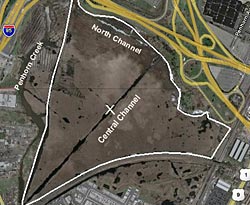
Figure 3. Map of Upper Penhorn Marsh study area in the Hackensack Meadowlands, New Jersey. 'X' marks the approximate location of the largest frog chorus at the intersection of the central channel and a smaller side channel. Boundaries of area surveyed for calling frogs are shown in white.
Water quality was poor in the four locations of each site where I recorded data. Dissolved oxygen was mostly 1 to 1.45 parts per million (range: 0 to 1.45 parts per million; 0 to 20% saturation), with a single reading of 0 parts per million in a "stagnant" area covered with plant debris and garbage in the southern corner of Upper Penhorn Marsh where I did not hear frogs. The following characteristics were also measured: salinity (range: 0.04 to 0.76 parts per thousand), water depth (7 to 20 centimeters, recorded only at Teterboro), temperature (23.0 to 25.3°C), specific conductance (0.11 to 1.44 millisiemens per centimeter, mS/cm), and pH (6.23 to 6.85). Maximum water depths were about 30 centimeters at locations where I did not make measurements. At Teterboro, measurements were limited to the Southeast Pond (I did not have access to the other two areas where frogs called).
Table 2 lists the most recent reports of frog species in the Meadowlands.
Discussion
Although only one species of frog was found on the surveys, the presence of small choruses of southern leopard frog in the freshwater wetlands of the Meadowlands is noteworthy. The southern leopard frog is common in southern New Jersey but is considered rare in northern New Jersey (Schwartz and Golden 2002; Jason Tesauro, Environmental Defense, personal communication 2007), where the Meadowlands are located. Several decades ago the southern leopard frog was considered extremely endangered in the Nassau County region of Long Island, New York (Schlauch 1978), but was common on Staten Island (Mathewson 1955). Recent surveys suggest that the southern leopard frog is now extirpated from Long Island; one population, and possibly a second, is known on Staten Island (Jeremy Feinberg, Rutgers University, personal communication), and the species is listed as of Special Concern in New York. The southern leopard frog is listed as Endangered in Pennsylvania, where urbanization is the principal threat and the species occurs only in the southern Delaware Valley (Hulse et al. 2001). Because of the location and urbanization of the Meadowlands, the presence of this frog is somewhat unexpected. It is possible that microclimate, reduced predation or competition, or the geochemical environment of the Meadowlands is favorable.
Eleven species of frogs, all native, occur in northeastern New Jersey (Conant and Collins 1991; Schwartz and Golden 2002). All 11 species have been reported in the Meadowlands in the past (Table 2), though not specifically within my study sites, which have not previously been surveyed for frogs (and I have been unable to trace some of the reports to confirm species identities). I was surprised not to hear other species of frogs during these surveys, inasmuch as habitats appeared suitable for, e.g., green frog (Lithobates clamitans melanota), bullfrog (Lithobates catesbeianus), and American toad (Anaxyrus americanus). Large-scale frog and toad surveys report the presence of green frogs, bullfrogs, and American toads in many habitats within urban areas (Chicago Wilderness Habitat Project 2005; Friends of the Rouge 2007), and, furthermore, bullfrogs, green frogs, and pickerel frogs were frequently found in sites with high levels of urban pollutants (Southerland and Stranko 2008). Certainly these recently reported species (probably with the exception of pickerel frog) are still present in the Meadowlands (Table 2). The absence of these and other species from Teterboro Airport and Upper Penhorn Marsh may be a result of metapopulation dynamics in the urban landscape. Subpopulations may frequently become extinct, and the reestablishment in suitable habitats may be restricted by physical barriers such as highways and salinity intrusion in waterways. Although I speculate on the habitat characteristics that may limit some species, longer-term studies are needed to determine habitat suitability or long-term constraints to colonization at these sites. Whereas it is likely that the eastern spadefoot (Scaphiopus holbrookii), not recorded in the Meadowlands since 1936, is extirpated from the area, other species that have been absent from reports relatively recently, such as Fowler's toad (Anaxyrus fowleri), may still occur in the Meadowlands. Small populations of frogs may go undetected due to lack of survey, urban noise interference, and localized distributions.
Urban noise per se could be a factor affecting frogs in the Meadowlands. In a laboratory experiment, males of the European common tree frog (Hyla arborea) decreased their calling activity as traffic noise playback levels increased. Single males were affected, whereas chorusing groups of males were not (Lengagne 2008). Presumably different species of frogs are differently affected by urban noise, and this may be a factor in the success of frog populations in the Meadowlands.
Many amphibians require habitats that contain pools of still water isolated from larger water bodies and containing abundant living or dead plant material. These small, quiet pools are vulnerable to the accumulation of pollutants. Although the pH of the pools at Teterboro and Penhorn, between 6 and 7, should not have been a challenge to northeastern amphibians, and likewise the water temperatures were not too high, dissolved oxygen (DO) and salinity characteristics were poor where I recorded data. Frog larvae are facultative air breathers, but low DO, often associated with eutrophication (Khan and Ansari 2005), may be stressful to some species (Noland and Ultsch 1981). Salinity, where I recorded data, was usually low (< 1 part per thousand); however, the highest readings observed might exclude the more sensitive species. Glooschenko et al. (1992) found that Rana sylvatica (a species not reported in the Meadowlands) was negatively associated with specific conductance levels. The southern leopard frog is known to tolerate mildly brackish water (Schwartz and Golden 2002, White and White 2002, Dodd and Barichivich 2007, Kenney et al. no date) and has been reported in another survey where few other species were present, despite apparent habitat suitability (Schueler et al. 1995). Water chemistry is usually a poor predictor of anuran species richness and presence in generally undisturbed areas; however, areas stressed by contaminants, such as the Meadowlands, may more likely show water chemistry influences on anuran species (Dale et al. 1985, Hecnar and M'Closky 1996).
Once an amphibian species has been extirpated from an urban area, it may be unable to recolonize due to the fragmented character of habitats and the lack of dispersal corridors, such as undeveloped riparian areas and unpolluted streams. The Teterboro area was intensively farmed during the early 1900s before airport development (Patrick Bonner, New York–New Jersey Port Authority, personal communication). A frog species like the spring peeper (Pseudacris crucifer), very common in rural areas of northeastern New Jersey, could have been extirpated from Teterboro by agriculture and land development and may have since been unable to recolonize, even though the habitat may now be suitable. The Upper Penhorn Marsh, on the other hand, may be currently unsuitable habitat for certain species. Although the Upper Penhorn Marsh is largely protected from salinity intrusion by a tidegate and stormwater pumping, and the quality of the habitat appears generally good, there is virtually no undeveloped upland adjoining the marsh. The spring peeper and many other amphibians, including common, ecologically tolerant species such as the green frog, require large areas (often many hectares) of adjacent wetland and upland habitats. This lack of the necessary adjacent habitat may make Penhorn unsuitable for establishment of a resident population of green frogs or spring peepers. The southern leopard frog may be able to survive in the Upper Penhorn Marsh because it requires little access to upland habitat, and it may be protected by the large expanses of common reed from flooding and pollution in Penhorn Creek.
One goal of many local public agencies and nongovernmental environmental organizations is to restore degraded wetlands in the Meadowlands to provide urban habitats suitable for a diversity of species. In connection with local development projects and remediation of solid waste landfills, the creation of freshwater wetland–upland habitat combinations with good water and soil quality could provide suitable habitats for additional species of frogs in the Hackensack Meadowlands. Similar habitats could support frogs in other urban areas of North America.
Successful restoration of frogs in urban habitats is possible. A created wetland in Vienna, Austria, was colonized by six species of frogs, and their success was attributed partly to the presence of dense adjoining woodland (Chovanec 1994); specific conductance was less than 0.4 (mS/cm). Habitat complexes in the Meadowlands that are suitable for frogs, including the sites of my 2006 study, and other urban locations where freshwater springs, pools, or wetlands exist in proximity to undeveloped upland, should receive full consideration for protection as habitat for frogs and many other organisms.
The frog community is useful as an indicator of biodiversity and environmental quality, and the public is interested in frogs, thus there might well be public support for continuing local studies of frogs. In order to monitor southern leopard frog populations, confirm the presence or absence of other species, and gauge the effectiveness of restoration projects, I recommend continuation of frog surveys in the Meadowlands. A network of automated remote recording devices ("frog loggers"; Heyer et al. 1994) can be established and calibrated to monitor frog choruses with less human effort than required by my field surveys. To obtain a more representative survey of frogs in the Meadowlands, other freshwater or nearly freshwater sites in the Meadowlands should also be monitored, such as Kearny Marsh West (Kearny Freshwater Marsh), a sand pit pond at Bellmans Creek, small pools at Laurel Hill, and two locations where bullfrogs were found recently at tributaries of Overpeck Creek.
Acknowledgments
For logistical support and information I thank Francisco Artigas, Patrick Bonner, Brett Bragin, Stuart Findlay, Christine Hobble, Joseph Sarnoski, and Bob Schmidt. Brett Bragin, Jeremy Feinberg, and Jason Tesauro commented on a draft of this paper, which was subsequently edited by Aryn Wilder. This study was funded by the Meadowlands Environmental Research Institute of the New Jersey Meadowlands Commission. This is a Bard College Field Station–Hudsonia Contribution.

